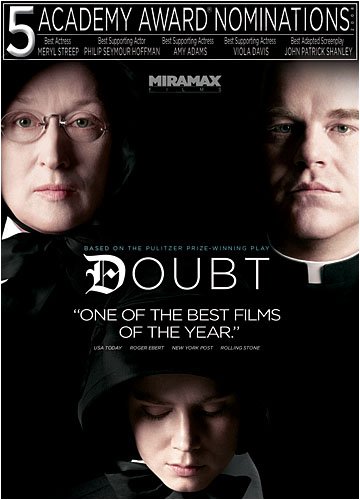All Nonfiction
- Bullying
- Books
- Academic
- Author Interviews
- Celebrity interviews
- College Articles
- College Essays
- Educator of the Year
- Heroes
- Interviews
- Memoir
- Personal Experience
- Sports
- Travel & Culture
All Opinions
- Bullying
- Current Events / Politics
- Discrimination
- Drugs / Alcohol / Smoking
- Entertainment / Celebrities
- Environment
- Love / Relationships
- Movies / Music / TV
- Pop Culture / Trends
- School / College
- Social Issues / Civics
- Spirituality / Religion
- Sports / Hobbies
All Hot Topics
- Bullying
- Community Service
- Environment
- Health
- Letters to the Editor
- Pride & Prejudice
- What Matters
- Back
Summer Guide
- Program Links
- Program Reviews
- Back
College Guide
- College Links
- College Reviews
- College Essays
- College Articles
- Back
Doubt
For those of us who have no certainty, writer/director John Patrick Shanley gives us “Doubt.” Shanley’s cast for his thought-provoking and controversial movie, Meryl Streep, Phillip Seymour Hoffman, Amy Adams, and Viola Davis portray their roles as well as they were written into the film. Set in 1964 in the Bronx , “Doubt tells the story of a nun and her suspicions. Sister Aloysius Beauvier (Streep), the principal of a tightly run catholic school, begins to feel there is an improper relationship forming between the school’s priest, Father Flynn (Hoffman). Sister James (Adams) confirms Sister Beauvier’s suspicions with her own. The “cat and mouse” game begins when Sister Beauvier takes matters into her own hands after she warns Mrs. Muller (Davis), the boy’s mother, who reluctantly admits she does not care what is happening to her son because it is “Only ‘til June.” Sister Beauvier confronts Father Flynn, who expectantly denies any such relationship and accuses her of being “out to get him” and “holding the church back from progressing.” The game continues as the film progresses and leaves the audience guessing who’s telling the truth until the very end.
If the storyline is not inviting enough, the big box-office names are. Streep, Hoffman, Adams, and Davis were all nominated for Academy Awards for their work in “Doubt.” The acting veterans in the film are each outshined in specific scenes including the one in which Davis’s character tearfully admits her indifference to her son’s possible pain. As always, Streep steals a few scenes with her strict, protective, and by-the-rule way of running things as she buts heads with Hoffman’s friendly, likable, and witty character, and clashes with Adams’s naïve and optimistic nature. The superb actors are truly at their best in the movie.
Each actor brilliantly plays his/her role to a T, but the real brilliance is in the remarkable camera angels used to define the scenes. For example, in the opening sconces the camera is angled as if it were hanging from the ceiling, hanging across the room and the viewer can still see the church members slowly filing in for Sunday morning mass. Another captivating shot is when Father Flynn is speaking from the pulpit about people who are sick and alone, have lost an only friend, and have done something wrong. The camera shows Father Flynn speaking, and in between dialog cuts to a shot of a specific member of the congregation that, due to its unusual tilt, is almost like a knowing glance, implying that the person who Father Flynn is speaking of is actually the one in the shot.
These angles and many more are what keep a viewer with a short attention span as the sometimes slow story unfolds.
This film’s intriguing story line, notable acting, and alluring camera angels all posses the audience’s thoughts, only allowing them time to reflect on everything once the credits are rolling. John Patrick Shanley did a phenomenal job on taking this moral drama from stage to screen.
Similar Articles
JOIN THE DISCUSSION
This article has 0 comments.

